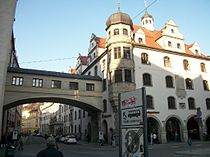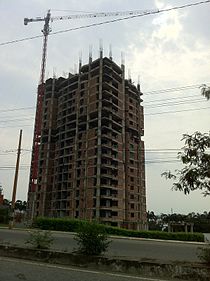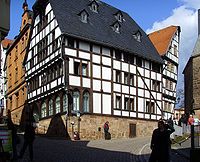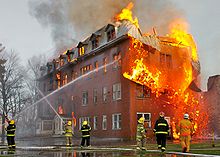- Building
-
In architecture, construction, engineering, real estate development and technology the word building may refer to one of the following:
- Any human-made structure used or intended for supporting or sheltering any use or continuous occupancy, or
- An act of construction (i.e. the activity of building, see also builder)
In this article, the first usage is generally intended unless otherwise specified.
Buildings come in a wide amount of shapes and functions, and have been adapted throughout history for a wide number of factors, from building materials available, to weather conditions, to land prices, ground conditions, specific uses and aesthetic reasons.
Buildings serve several needs of society – primarily as shelter from weather and as general living space, to provide privacy, to store belongings and to comfortably live and work. A building as a shelter represents a physical division of the human habitat (a place of comfort and safety) and the outside (a place that at times may be harsh and harmful).
Ever since the first cave paintings, buildings have also become objects or canvasess of artistic expression. In recent years, interest in sustainable planning and building practices has also become part of the design process of many new buildings.
Contents
Definitions
Building is defined in many aspects as:
- As a Civil Engineering structures such as a house,worship centre,Factories etc. that has a foundation,wall,roof etc. that protect human being and their properties from direct harsh effect of weather like rain,wind,sun etc.
- The act of constructing, erecting, or establishing.
- The art of constructing edifices, or the practice of civil architecture.
- That which is built; a fabric or edifice constructed, as a house, a church, castle, arena/ stadium, etc.
- The act of constructing or building something; "during the construction we had to take a detour"; "his hobby was the building of boats"
- The commercial activity involved in constructing buildings; "their main business is home construction"; "workers in the building trades"
- A structure that has a roof and walls and stands more or less permanently in one place; "there was a three-storey building on the corner"; "it was an imposing edifice"
- The occupants of a building; "the entire building complained about the noise"
To differentiate buildings in the usage of this article from other buildings and other structures that are not intended for continuous human occupancy, the latter are called non-building structures or simply structures.
Structural height in technical usage is the height to the highest architectural detail on building from street-level. Depending on how they are classified, spires and masts may or may not be included in this height. Spires and masts used as antennas are not generally included.
The definition of a low-rise vs. a high-rise building is a matter of debate, but generally three storeys or less is considered low-rise.[citation needed]
History
The first shelter on Earth constructed by a relatively close ancestor to humans is believed to be built 500,000 years ago by an early ancestor of humans, Homo erectus.[1]
Types
Residential
Residential buildings are called houses/homes, though buildings containing large numbers of separate dwelling units are often called apartment buildings or apartment blocks to differentiate them from the more 'individual' house.
Building types may range from one-room wood-framed, masonry, or adobe dwellings to multi-million dollar high-rise buildings able to house thousands of people. Increasing settlement density in buildings (and closer distances between buildings) is usually a response to high ground prices resulting from many people wanting to live close to work or similar attractors.
Multi-storey
A multi-storey building is a building that has multiple floors above ground in the building.
Multi-storey buildings aim to increase the area of the building without increasing the area of the land the building is built on, hence saving land and, in most cases, money (depending on material used and land prices in the area).
Creation
The practice of designing, constructing, and operating buildings is most usually a collective effort of different groups of professionals and trades. Depending on the size, complexity, and purpose of a particular building project, the project team may include:
- A real estate developer who secures funding for the project;
- One or more financial institutions or other investors that provide the funding
- Local planning and code authorities
- A Surveyor who performs an ALTA/ACSM and construction surveys throughout the project;
- Construction managers who coordinate the effort of different groups of project participants;
- Licensed architects and engineers who provide building design and prepare construction documents;
- Landscape architects;
- Interior designers;
- Other consultants;
- Contractors who provide construction services and install building systems such as climate control, electrical, plumbing, Decoration, fire protection, security and telecommunications;
- Marketing or leasing agents;
- Facility managers who are responsible for operating the building.
Regardless of their size or intended use, all buildings in the US must comply with zoning ordinances, building codes and other regulations such as fire codes, life safety codes and related standards.
Vehicles—such as trailers, caravans, ships and passenger aircraft—are treated as "buildings" for life safety purposes.
Ownership and funding
- Mortgage loan
- Real estate developer
Building services
Physical plant
Any building requires a certain amount of internal infrastructure to function, which includes such elements like heating / cooling, power and telecommunications, water and wastewater etc. Especially in commercial buildings (such as offices or factories), these can be extremely intricate systems taking up large amounts of space (sometimes located in separate areas or double floors / false ceilings) and constitute a big part of the regular maintenance required.
Conveying systems
Systems for transport of people within buildings:
Systems for transport of people between interconnected buildings:
Building damage
Buildings may be damaged during the construction of the building or during maintenance. There are several other reasons behind building damage like accident.[2] Buildings also may suffer from fire damage and flooding in special circumstances.[3]
See also
- Autonomous building
- Building material
- Earthquake engineering
- Famous buildings
- Float glass
- Green building
- Hurricane-proof building
- List of building types
- List of largest buildings in the world
- Natural building
- Natural disaster and earthquake
- Nonbuilding structure
- Skyscrapers
- Steel building
- Commercial modular construction
References
- ^ "World's oldest building discovered". BBC News. 2000-03-01. http://news.bbc.co.uk/1/hi/sci/tech/662794.stm. Retrieved 2010-01-02.
- ^ Building Damage
- ^ Euro-House.ru
Real estate developments Commercial Business park · Office building · Ports and waterfronts · Retail park · Shopping mall / center · Shopping streets and districts · Warehouse DistrictIndustrial Residential Science / Education Municipal Buildings Miscellaneous Rooms, spaces, and architectural elements Public areas - Airport lounge
- Auditorium
- Cafeteria
- Classroom
- Changing room / Locker room
- Conference hall
- Doctor's office
- Function hall
- Mailroom
- Library
- Lobby
- Office
- Refectory
- Restroom
- Security
- Waiting room
Passages and spaces Utility and storage - Attic
- Basement
- Box room / Carport
- Cloakroom
- Closet
- Electrical room
- Equipment room
- Furnace room / Boiler room
- Garage
- Janitorial closet
- Laundry room / Utility room
- Mechanical room / floor
- Pantry
- Root cellar
- Semi-basement
- Studio
- Server room
- Wardrobe
- Workshop
- Vault
- Wine cellar
- Wiring closet / Demarcation point
Shared residential rooms Private rooms Great house areas - Ballroom
- Butler's pantry
- Buttery
- Drawing room
- Fainting room
- Great chamber
- Great hall
- Larder
- Long gallery
- Lumber room
- Parlour
- Root cellar
- Salon
- Saucery
- Scullery
- Servants' hall
- Servants' quarters
- Smoking room
- Solar
- Spicery
- Stillroom
- Undercroft
Other areas Architectural elements Related terms - Building
- Furniture
- House
- House plan
- Rooms
Categories:- Buildings and structures
- Building
- Real estate
Wikimedia Foundation. 2010.





